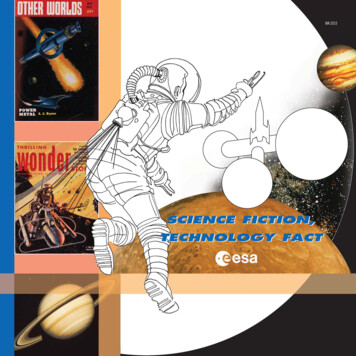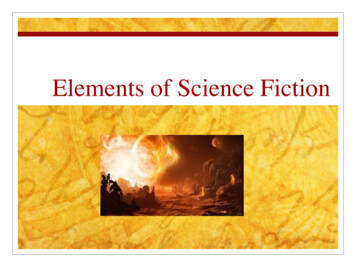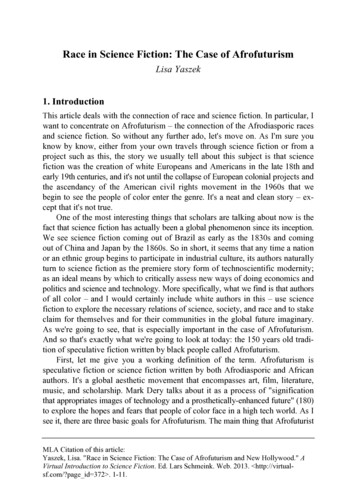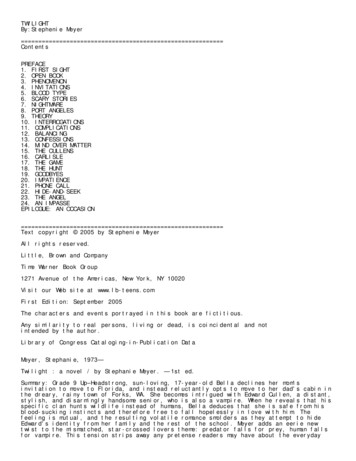
Transcription
BR-205SCIENCE FICTION,TECHNOLOGY FACT
INTRODUCTIONArtwork has played an influential and central role in science fiction literature. It has partlypartly defineddefinedthe scope of the genre and has brought the startling and imaginative visions of outerouter space,space,exploration of other worlds, interplanetary spaceflight and extraterrestrial beings into thethe mindsmindsand consciousness of the general public. In magazines and books, film and television, advertising andandvideo, the artist’s vision has transformed words into dazzling and compelling images that stillstill liftliftthe spirits and brighten the soul.A range of books gives wonderful examples of book and magazine covers, as wellas paintings, illustrations and film posters, depicting science fiction themes and scenes.They trace the history and development of science fiction art, giving many examplesof the images behind the stories, noting the technologies and ideas inherent in thepictures, and describing the lives and works of the artists and illustrators. Pulpmagazines, with their lurid covers and thrilling, violent, sex-laced and fantasy-filledstories, fostered the talents of some of the greatest popular writers of the time andvirtually invented the genre of science fiction.Although fantasy and science fiction tales were published occasionally and artistshad depicted fantasy scenes in engravings for many years, the first science fictionmagazine proper, Amazing Stories, appeared in 1927, published and edited by HugoGernsback, a native of Luxembourg, with all the covers and interior artwork done byFrank Rudolph Paul, a native of Austria. Since then, the genre – full of descriptions ofspace technologies and systems, often just pure imagination but sometimes based onsome semblance of fact – has never looked back.2
A couple of years ago, ESA studied science fiction literature, artwork and filmsto see whether there were any ideas, particularly in older stories, that might beworth a closer look today given the new advances in technologies. The study wascarried out by the Maison d’Ailleurs in Yverdon-les-Bains, Switzerland, whichhouses one of the largest collections of science fiction literature in the world.Seeing some of the wonderful cover pictures of the books and magazines in thecollection – essentially lost art – and noting the unfettered imagination of theartists as they depicted their chosen scenes forty, fifty, sixty years ago, promptedthe idea of selecting some of the thousands of covers and juxtaposing them withthe reality of today. Showing, for example, what space stations actually look likein space today compared with how artists many years ago imagined they mightappear – long before they were on the drawing boards and even before the firstsatellite had been launched.There are numerous examples of concepts proposed or illustrated in early science fiction writings that have become reality. Examples include:ultra-high velocity projectile launchers (1865); retro-rockets (1869); planetary landers (1928); rocket fins for aerodynamic stability (1929);vertical assembly buildings (1929); clustered rocket boosters (1929); spacewalks, pressure suits, life-support tethers (1929); the construction ofan orbital space station complete with living quarters using materials ferried up, with regular service visits (1945); communications via satellitesin geostationary orbit (1945); solar and light sails (1920, 1951, 1963); multiple propellant storage tanks (1954); streamlined crew modules foratmospheric entry (1954).What this book gives is a tiny sampling of science fiction book and magazinecovers from the collection of Maison d’Ailleurs, together with images from ESA’s ownphotograph collection. The idea is to show how close or how far was an early artist’sconception from what was later built and launched. In many instances, we are not yet atthe stage that science fiction authors and artists imagined. While we have constructed ahandful of space stations – in very different forms to that imagined by most science fictioncovers – we have not yet established settlements on planets (or indeed in space), norhave we yet achieved interplanetary flight. On the other hand, some of the renderings ofspacesuits or planetary landers and rovers are close to what we employ in space today.This is interesting because early science fiction authors, artists and illustrators describedspace concepts and spacecraft based on the limited scientific knowledge available at thetime, whereas more modern writers generally portray the same basic systems as used inreal-life spaceflight, even though artistic licence is often employed. In addition, advancessuch as miniaturisation and robotics provide modern writers and illustrators with thebenefit of existing and proven technologies that can be directly adapted. Anythingproduced much before the first satellite, Sputnik, appeared in 1957 was more a productof real artistic inventiveness.
SUPPLYINGSTORES IN SPACEThe Automated Transfer Vehicle (ATV) is an unmanned ferry designed to supply the InternationalSpace Station (ISS) with equipment, food, clothing, water, air (nitrogen and oxygen), propellant andother stores. ATV approaches and docks with the ISS automatically, where it can remain attachedfor up to six months, during which time it can support the attitude control of the station and reboostit to compensate for atmospheric drag. In addition, the ATV disposes of waste from the ISS byburning up in the atmosphere over the ocean. A series of ATV’s are planned as part of ESA’scontribution to the ISS programme.4
The ATV, due for its maiden voyage in early 2005, is across between a tugboat, river barge and cargo ship.Once docked with the ISS, astronauts (inregular clothing rather than spacesuits)access the 7.5 tonnes of cargoand offload supplies whenrequired from the pressurisedhold, gradually replacingthem with 6.5 tonnes ofwaste. Once theunloading/loadingis completed andthe vehicle’s job isfinished, itseparatesautomaticallyfrom the ISSand goesinto asteepreentrypathto ensuredestruction.
LIVING IN SPACEThe idea of a space station has been around formore than 100 years. In 1902, RussianKonstantin Tsiolkovsky described a greenhousein space where cosmonauts would grow theirown food in an environment similar to that onEarth. The concept was studied by American(Robert Goddard) and German (HermannOberth) pioneers some twenty years later andthen again by Wernher von Braun in the 1950s.However, it was not until 1971 that the SovietUnion placed the first space station (Salyut-1)into orbit, where it was occupied for severalweeks. Over the next ten years or so, moremanned stations were launched by the USSR,culminating in 1986 with the next-generationMir. This modular station was expanded andstayed aloft almost continuously manned for 15years before reentering the atmosphere in March2001. During its time, it was also visited byAmerican and European astronauts.6
The Americans launched their initial space station,Skylab – created from the third stage of a spare Saturn-5Moon rocket – in 1973 and it was occupied by threecrews before being abandoned, as planned, in 1974.It was eventually guided to disintegration in theatmosphere in 1979. By then, a somewhat moreambitious laboratory, ESA’s Spacelab, was in the worksand it was first launched in 1983 aboard a Space Shuttle. Although not a true space station, Spacelab was a cylinder with a diameter of 4 m anda length of 6 m and, housed in the Shuttle cargo bay, offered a shirt-sleeve working environment. The last Spacelab flight took place in 1998, butthe extensive experience provided the foundation for ESA’s Columbus ISS module.In 1984, the United States committed itself to building a permanently manned space station – and invited other nations to participate. Europe,Canada and Japan responded with enthusiasm, but it was many years before the wrangling and politics, plus the dissolution of the USSR andsubsequent accession of Russia to the programme, settled down sufficiently to allow the base in space to progress.The International Space Station is the most ambitious international space project ever undertaken, with 16 nations collaborating to create anorbital laboratory that will conduct research for the benefit of people on Earth. Construction began in November 1998 and, by the end of 2003,after nearly 40 missions to assemble and equip it, the orbital station is about a third of the way towards completion.The design of the ISS is very different from the spoked-wheel concept of many science fiction images. Early science fiction writers portrayedspacecraft and systems based on the scientific and technical knowledge available at the time. The wheel design reflected the belief that thediscomfort and potential fatality of weightlessness must be combated by rotating the station to create artificial gravity, with the crew working andliving inside the rim. With the founding of the US civil space programme in 1958 and the preparation of detailed space station designs, the wheelshape was found to be impractical and it was decided that docked modules offered the best approach. By 1970, both the USA and the USSR wereplanning modular designs for their stations. All modern space stations – Salyut, Skylab, Mir, the ISS – have been based on the cylinder. Cylindricalmodules are added as necessary for living quarters, laboratories and utilities. In addition, huge Sun-following solar panels provide power, a featuremissing from the science fiction pictures. One wonders how the artists conceived power being supplied to their circular stations.
GETTINGAROUNDIN SPACEIn science fiction, a huge variety of personal transportation devices iscalled on to let astronauts move around outside their spaceships. Theyinclude anti-gravity devices, self-propelled rocket backpacks, tethers andumbilical cords, and teleportation. In real life, though, the number ofdevices used for extravehicular activity (EVA) is far fewer!In an EVA, or spacewalk, an astronaut leaves the protective environment of thespacecraft’s pressurised cabin and ventures into the vacuum of space wearing aspacesuit. In the early days of EVAs, the astronaut was always attached to the spacecraftat all times by a safety tether. The tether provides general freedom of movement, but canlimit some tasks because it is too short, may have to be moved to another attachmentpoint, become entangled or offer no control8
Personal manoeuvring units were developed because astronauts found tethers too restrictive; they offer more freedom and allow the user to roam further afield. One of thefirst was NASA’s Manned Maneuvering Unit (MMU), a nitrogen-propelled backpack controlled by joysticks at the end of the arm rests. Moving the controllers left or right orpulling them fired nitrogen thrusters to propel the astronaut in different directions. The MMU snapped onto the back of a spacesuit’s life-support backpack and allowed theastronaut to work outside without a tether as much as 100 m away from the Space Shuttle for up to six hours at a time.The MMU was an experiment – although big and bulky, it was successful. When the suited astronaut attached the MMU to his suit, the ensemble became a self-containedmachine that could be used to capture a malfunctioning satellite. On one of its three flights, in 1984, it was used to rescue an ailing solar observatory, bringing it to theSpace Shuttle for repair.NASA’s Shuttle and ISS spacesuit (EMU; Extravehicular Mobility Unit) is anindependent suit that provides the astronaut with environmental protection, mobility,life support and communications. The EMUs, which come in various sizes, providethe necessities for supporting life, such as oxygen, a pressurised enclosure andtemperature control. It also protects against radiation, micrometeoroids and theextremes of heat and cold. The self-contained life-support system contains seven hoursof expendables, including oxygen, a battery for electrical power, water for cooling,lithium hydroxide for carbon dioxide removal and a 30-minute emergency life-supportsystem. Because it is self- contained, the EMU eliminates the need for a suit-tospacecraft supply line or umbilical.
FASHION IN SPACEThe environments faced by astronautsduring launch, life in space andspacewalks are very different, sotheir wardrobe includes differenttypes of clothing. During Shuttlelaunch and reentry, a special suit is worn that is partially pressurised toprevent the excessive flow of blood from the brain to the legs onceterrestrial gravity regains its grip. The suit is also fitted with anemergency parachute in case it is necessary to jump out of the Shuttle.Inside the Shuttle or ISS, the atmosphere is carefully controlled in termsof pressure, content and temperature so no special clothing is necessary,with the proviso that whatever is worn is hygienic and non-flammable.Clothing can be comfortable (preferablywith pockets to keepsmall items fromfloating around) andshoes are necessaryonly during exercise.10
Some of the biggest fashion houses are involved in designing clothing for space andare experimenting with different fabrics, materials and technologies to improvehygiene, comfort and safety. The harsh environment of space demands strong yetlightweight materials able to withstand extremely high temperatures and impact forces.Space technology developments to create these innovative garments are benefiting theterrestrial textile and clothing industries. Fashion spin-offs from space include: jackets that embed wearable antennas; intelligent shirts, embodying shape-memoryalloy threads, which can be ironed simply usinga hair dryer, or with sleeves that can go fromlong to short by the application of hot air; overalls that keep the wearer cool in hotconditions or warm in cold climates; glasses that demist themselves.
LANDINGAND ROVINGOFF-EARTHIf defying gravity and taking off from the Earth is still a major undertaking, then landingon a planet millions of kilometres away is even more challenging. Not only does aspacecraft have to travel an extremely long distance to find its target, it then has to landin a pre-selected area in such a way that it is not damaged – a difficult feat when theprecise surface features are largely unknown.Landers come in various shapes and sizes, ranging from highly complex manned lunarlanders with a requirement to take-off again to automated sample analysers that stayput. Unmanned landers are becoming smarter, able to guide themselves to the surfaceusing sensors and cameras to check out the landing zone and avoid hazards such asrocks and craters. In future, they will carry impact protection systems lighter than thetough but heavy airbags used at present on some landers. Landing gear is beingdesigned with shock absorbers to survive impact on uneven and rough terrain and soavoid toppling over. More sophisticated technologies will also allow future landers tocarry more equipment, for example, ground-penetrating radar, drills and hoists forcollecting rock and soil samples for in-situ analysis or eventual return to Earth.12
But simply landing and staying in one place is often not enough. The terrain fartherafield may need to be explored and sampled. This is a job for the rover – a smallwheeled, tracked or legged vehicle capable of slowly moving over a planet’s surfaceand communicating back to its parent lander or orbiter or even directly with Earth.Current rovers can cover some 100 m each day and over a kilometre during thewhole mission. They also rely on smart technologies to know where they are, wherethey want to go and which soil and rock samples are worth studying and collecting.To explore a planet further, future generations of roversmust go farther and faster. One approach to long-rangemobility is inflatable rovers, which would use very large,inflatable wheels to climb over rocks instead of travellingaround them. These rovers would be inflatedonly after arrival. This has the advantagethat, when deflated, it can occupy a smallervolume than a conventional rover and whendeployed can be much bigger.Another inflatable structure, the balloon,offers additional advantages. It can flycloser to the surface than an orbiter, andprovide a better observation platform that asurface rover, while covering far greaterdistances. It could even land and take-offagain, as could micro-airvehicles or entomopters.These are extremely smallintelligent spacecraft capableof flight, motion and theunique vision andsensor characteristicsof insects.
MAKING GOOD USE OF SPACESome of the pictures show the interiors of imagined spacecraft. Even so,the accommodation looks fairly cramped. For the first few years of the ISS,the living quarters of the astronauts is the Russian Zvezda module, whichis an updated version of Mir’s core module. At 13 m long, Zvezda is aboutthe size of a small boat and provides sleeping, eating and bathroom areas.There is also a treadmill and bicycle. The eating-kitchen area has a foodheater, a fridge-freezer, food cupboard, table and chairs. The sleeping areacomprises a couple of cabins where the crew can sleep, relax and havesome privacy away from it all. The bathroom has a toilet and wash unit.In outer space, all surfaces become equally important, and every inch mustbe used efficiently. Every available patch is used for equipment racksand storage units and the emphasis is onmaking optimum use of materials and technologies that collapse, fold, inflate, deflate,expand, contract and extend to save space.14
Over the years, interior designers and architects have been involved in designing theinterior of Skylab, the structure of the ISS, and futuristic space hotels. More so thanconventional terrestrial houses, the design of manned spacecraft and space stations ashabitable environments has had to consider psycho-physiological safety and efficiencyissues in addition to all the challenges of living in space and the effects of weightlessness. Design concepts have incorporated smooth surfaces for easy cleaning, wastemanagement compartments, storage modules, water supply, storage and recyclingunits, food freezers, air filtration and quality systems, and colours for ease ofidentification and to suit moods and give some semblance of home.
ROBOTSThe term robot appears to have been first used in 1921 in aCzech play describing a utopia where humans were waited onby machine servants. However, such automata were wellknown in Victorian times and were manufactured in quantityduring 1880-1920. These mechanical dolls and toys could perform simple movements: turn heads, movearms and legs, put tongue out and so on. Others were more sophisticated and quite complex, usinghydraulic or pneumatic devices. Some could sing, play instruments or walk. One could actually negotiateits way across a room to pour drinks for guests. Their origin, in fact, lies much earlier. Mechanical writerswere invented and built in 1753. Several spectacular automata of the late 18th century include a life-sizeand life-like figure of a boy seated as a desk, capable of writing any message of up to 40 letters. Therewas also a similar figure of a boy who drew four sketches (of a dog, a cupid, the head of Louis XIV, andthe profiles of Louis XVI and Marie Antoinette), and there wasa young girl who played the clavichord by the pressure of herown fingers upon the keys.The first commercial robot was devised in 1956 in America and today,nearly fifty years later, millions of robots are used for routine banal jobs infactories, laboratories and elsewhere, for example, to cut, join, weld, sprayand inspect parts. Other types are autonomous vehicles that can workunderwater, on planetary surfaces or be used for entertainment, as in the‘Robot Wars’ television series. Those with some form of legged locomotionare often like spiders or insects with six or eight legs. However, very fewconform to the mechanical humanoid so often depicted in science fictionstories and films. Making a machine capable of supporting itself on twolegs and walking, moving and carrying out tasks commonplace for humansremains a daunting challenge for robot designers.16
Nevertheless, serious attempts are being made to construct two-legged robots. In Japan,Honda has created a series of humanoid robots culminating in Asimo, based on the‘P3’ (Prototype 3), a 1.6 m-tall machine, completed in 1997, that can walk at morethan 1.5 kph and navigate around furniture. P3’s proportions and the positions of itsjoints were adapted from the human body.Compared to P3, Asimo’s weight and height were significantly reduced (43 kg and1.20 m). Its size was chosen for it to operate freely in the human living space and tomake it people-friendly. This size allows Asimo to operate light switches anddoorknobs and to work at tables and workbenches.The Asimo two-legged walking technology features predicted movement control inaddition to the earlier walking control technology, providing more flexible walking.As a result, the robot walks more smoothly and more naturally. The introduction ofintelligent, real-time, flexible-walking i-WALK technology allows the robot to walkcontinuously while changing directions, and gives it even greater stability in responseto sudden movements. Honda has also introduced a speech feature to make theoperation of Asimo easier. The robot can recognise and respond to some 50 differentcalls, greetings and queries in Japanese, and can move its body and arms in responseto about 30 different action commands in Japanese.But these mobile robots have a rival in immobots (immobile robots). It is costly to produceand maintain physical robots and there is a trend towards the use of autonomous networkedsoftware agents known as immobots. They can look inside themselves, whereas traditional robotsfocus on exploring and manipulating their external environment. This inner focus enables themto control their complex internal functions such as sensor monitoring and goal tracking,parameter estimation and learning, failure detection and isolation, fault diagnosis, avoidanceand recovery. Immobots thus have a great potential as automomous space probes, capable ofrepairing themselves.
Di Fate, V.Infinite worlds: the fantastic visions of science fiction artPenguin Studio, 1997Frewin, A.100 years of science fiction illustration: 1840-1940Hart-Davis, MacGibbon Ltd, 1975REFERENCESHaining, P.The classic era of American pulp magazinesChicago Review Press, 2000Hershenson, B. & Allen, R.Horror, sci-fi & fantasy movie postersBruce Hershenson, 1999Launius, R. D. & McCurdy, H. E.Imagining space: achievements, predictions, possibilitiesChronicle Books, 2001Raitt, D. et al:Innovative Technologies from Science Fiction from Space ApplicationsEuropean Space Agency, 2001 (ESA BR-176)Reibaldi, G. & Caprara, G.Space base Europe: how the International Space Stationis used to improve life on EarthEuropean Space Agency, 2002Robinson, F. M.Science fiction of the 20th century: an illustrated historyCollectors Press, 1999Zukowsky, J. (ed)2001: building for space travelHarry N. Abrams, Inc., 2001All SF images are from the collection Maison d'Ailleurs/Agence Martiennecover: Others Worlds (29 - 5.1953, ill. Malcolm Smith); Thrilling Wonder Stories (41/3- 2.1953, ill. J. Coggins), p2: Amazing Stories (21/4 - 4.1947, ill. J.S. Krupa), p3:Météor (136 - 9.1964); Amazing Stories (12.1966, ill. Frank R. Paul), p4: AmazingStories (36/6 - 6.1962, ill. Alex Schomburg), p5: Murray Leinster, Space Tug (PocketBooks, 1955, ill. Robert Schulz); Galaxy Science Fiction (49, ill. Jack Coggins), p6: HenryBings, Lockende Zukunft (Bewin-Verlag, 1957), p7: Amazing Stories (35/11 - 11.1961,ill. Alex Schomburg); If Worlds of Science Fiction (1/9, ill. Ken Fagg), p8: MeccanoMagazine (7 - 5.1958, ill. Eko); Amazing Stories (38/10 - 10.1964, ill. Emsh); Spazio(22 - 1.1961, ill. Robert), p9: Thrilling Wonder Stories (44/4 - 1954, ill. Walter Popp),p10: Croisière en l’an 2000 (Éditions O.K., 1946), p11: Street Comix (1/2 - 1952);Thrilling Wonder Stories (38/3 - 8.1951, ill. Earle Bergey), p12: Peter Randa, PlateForme de l'Eternité (Fleuve Noir, Anticipation 227, 1963, ill. Brantonne), p13: TheMagazine of Fantasy and Science Fiction (2/3 - 2.1961, ill. Chesley Bonestell); Eric FrankRussel, Three to Conquer (Sogensha Co., 1965); Analog Science Fact & Science Fiction72/6 - 2.1964, ill. John Schoenherr), p14: Galaxy (16/3 - 7.1958, ill. Dembe), p15:Amazing Stories (36/2 - 2.1962, ill. Alex Schomburg); Future Science Fiction (4/2 7.1953, ill. Luros), p16: Amazing Stories (39/6 - 6.1965, ill. Gray Morrow), p17:Science-Fiction plus (12.1953, ill. Frank R. Paul), p18: The Complete Book of Space Travel(World, 1963, ill. Virgil Finlay); Leopold Massiéca, La Course aux Étoiles (J. Ferenczi,1953); E. J. Allingham, The Robot Man, The Boy’s Friend Library (271 - 1.1931)18IMAGES: Maison d’ Aillews: 2,3,4,5,6,7,8,9,10,11,12,13,14,15,17,18.ESA: 4,5,6,10,11,15,16. NASA: 2,7,8,9,12,13,14.American Honda Motor Co., Inc: 17
BR-205Science Fiction,Technology Fact ESA Publications 2004ConceptDavid RaittEditorBarbara WarmbeinDesign & LayoutLeigh EdwardsISBN92-9092-647-3ISSN1608-4799
A range of books gives wonderful examples of book and magazine covers, as well as paintings, illustrations and film posters, depicting science fiction themes and scenes. They trace the history and development of science fiction art, giving many examples of the images behind the s










